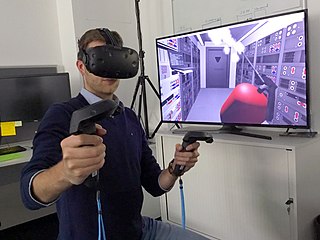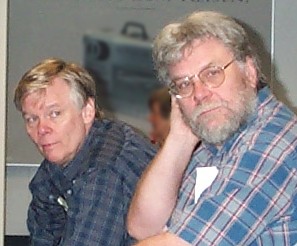
Rendering or image synthesis is the process of generating a photorealistic or non-photorealistic image from a 2D or 3D model by means of a computer program. The resulting image is referred to as the render. Multiple models can be defined in a scene file containing objects in a strictly defined language or data structure. The scene file contains geometry, viewpoint, texture, lighting, and shading information describing the virtual scene. The data contained in the scene file is then passed to a rendering program to be processed and output to a digital image or raster graphics image file. The term "rendering" is analogous to the concept of an artist's impression of a scene. The term "rendering" is also used to describe the process of calculating effects in a video editing program to produce the final video output.

Virtual reality (VR) is a simulated experience that can be similar to or completely different from the real world. Applications of virtual reality include entertainment and education. Other distinct types of VR-style technology include augmented reality and mixed reality, sometimes referred to as extended reality or XR.
Artificial reality is a book series by Myron W. Krueger about interactive immersive environments, based on video recognition techniques, that put a user in full, unencumbered contact with the digital world. He started this work in the late 1960s and is considered to be a key figure in the early innovation of virtual reality. For 16 years Krueger was creating a computer system that connected the actions of a user to the real-time response of visual and auditory displays. Artificial Reality was published in 1983 and updated in Artificial Reality II in 1991. Artifical Reality II was to explore the concept of 'Videoplace', which is when a users body is implimented into a computer created world full of color, sound, and visuals. Whillst the first interation of the series Artifical Reality has laid the ground work for different branches of computer-generated worlds like Virtual Reality and Augmented Reality. Visualization is key for all artifical realities to efficiently use data; resulting in being able to utilize human sensory systems that create these artifical realities.

ACM SIGGRAPH is the international Association for Computing Machinery's Special Interest Group on Computer Graphics and Interactive Techniques based in New York. It was founded in 1969 by Andy van Dam.

Scott Fisher is the Professor and Founding Chair of the Interactive Media Division in the USC School of Cinematic Arts at the University of Southern California, and Director of the Mobile and Environmental Media Lab there. He is an artist and technologist who has worked extensively on virtual reality, including pioneering work at NASA, Atari Research Labs, MIT's Architecture Machine Group and Keio University.
Michael Frank Deering is a computer scientist, a former chief engineer for Sun Microsystems in Mountain View, California, and a widely recognized expert on artificial intelligence, computer vision, 3D graphics hardware/software, very-large-scale integration (VLSI) design and virtual reality. Deering oversaw Sun's 3D graphics technical strategy as the chief hardware graphics architect and is a co-architect of the Java 3D API, developing Java platform software. He is the inventor of deferred shading, inventor of Geometry compression, co-inventor of 3D-RAM, and the chief architect for a number of Sun's 3D graphics hardware accelerators. Many of his inventions have been patented.
In the mid-1970s, Myron Krueger established an artificial reality laboratory called the Videoplace. His idea with the Videoplace was the creation of an artificial reality that surrounded the users, and responded to their movements and actions, without being encumbered by the use of goggles or gloves. The work done in the lab would form the basis of his much cited 1983 book Artificial Reality. The Videoplace, was the culmination of several iterations of artificial reality systems: GLOWFLOW, METAPLAY, and PSYCHIC SPACE; each offering improvements over the previous installation until VIDEOPLACE was a full blown artificial reality lab at the University of Connecticut.
Thomas Albert "Tom" DeFanti is an American computer graphics researcher and pioneer. His work has ranged from early computer animation, to scientific visualization, virtual reality, and grid computing. He is a distinguished professor of Computer Science at the University of Illinois at Chicago, and a research scientist at the California Institute for Telecommunications and Information Technology (Calit2).
The Electronic Visualization Laboratory (EVL) is an interdisciplinary research lab and graduate studies program at the University of Illinois at Chicago, bringing together faculty, students and staff primarily from the Art and Computer Science departments of UIC. The primary areas of research are in computer graphics, visualization, virtual and augmented reality, advanced networking, and media art. Graduates of EVL either earn a Masters or Doctoral degree in Computer Science.

Rebecca Allen is an American designer, artist, pioneer, researcher, and educator, known for her research in the field of digital art. Starting in the 1970s, Allen started to compose works for computer imaging. This included still graphics, animation, television logos, music videos, video games, large-scale performance work, artificial life systems, and interactive installations. Her work addresses humanizing technology.
James David Foley is an American computer scientist and computer graphics researcher. He is a Professor Emeritus and held the Stephen Fleming Chair in Telecommunications in the School of Interactive Computing at Georgia Institute of Technology. He was Interim Dean of Georgia Tech's College of Computing from 2008–2010. He is perhaps best known as the co-author of several widely used textbooks in the field of computer graphics, of which over 400,000 copies are in print and translated in ten languages. Foley most recently conducted research in instructional technologies and distance education.

Maurice Benayoun is a French pioneer, contemporary new-media artist, curator and theorist based in Paris and Hong Kong. Often conceptual, Maurice Benayoun's work constitutes a critical investigation of the mutations in the contemporary society induced by the emerging or recently adopted technologies.

Immersion into virtual reality (VR) is a perception of being physically present in a non-physical world. The perception is created by surrounding the user of the VR system in images, sound or other stimuli that provide an engrossing total environment.
A projection augmented model is an element sometimes employed in virtual reality systems. It consists of a physical three-dimensional model onto which a computer image is projected to create a realistic looking object. Importantly, the physical model is the same geometric shape as the object that the PA model depicts.

Collaborative virtual environments, or CVEs, are used for collaboration and interaction of possibly many participants that may be spread over large distances. Typical examples are distributed simulations, 3D multiplayer games, collaborative engineering software, and others. The applications are usually based on the shared virtual environment. Because of the spreading of participants and the communication latency, some data consistency model have to be used to keep the data consistent.

Immersive technology refers to technology that attempts to emulate a physical world through the means of a digital or simulated world by creating a surrounding sensory feeling, thereby creating a sense of immersion. Immersive technology enables mixed reality; which is a combination of Virtual reality and Augmented reality or a combination of physical and digital. in some uses, the term "immersive computing" is effectively synonymous with mixed reality as user interface.
Scenario is an Artificial Intelligence (AI) computer graphic interactive installation, directed by the artist Dennis Del Favero, and developed in collaboration with scriptwriter Stephen Sewell, AI scientist Maurice Pagnucco working with computer scientists Anuraag Sridhar, Arcot Sowmya and Paul Compton. It is a 360-degree 3D cinematic work whose narrative is interactively produced by the audience and humanoid characters. The title is a Commedia dell'arte term referring to the way dramatic action is dependent on the way actors and audience interact. Scenario was developed at the iCinema Centre for Interactive Cinema Research.

Diane Gromala is a Canada Research Chair and a Professor in the Simon Fraser University School of Interactive Arts and Technology. Her research works at the confluence of computer science, media art and design, and has focused on the cultural, visceral, and embodied implications of digital technologies, particularly in the realm of chronic pain.

Toby L. J. Howard is an Honorary Reader in the Department of Computer Science at the University of Manchester in the UK, He was Director of undergraduate studies 2011-2019. He retired from the University in July 2020.
Ulrike Gabriel was born in 1964 in Munich and is an artist and researcher focussing on generative systems. Ulrike co-founded the laboratory Codelab, Berlin where she spent some time as a director. She also worked in ecological agriculture in Argentina from 2003 to 2006. Ulrike was also a professor at the University of Art and Design HfG Offenbach (2006-2012). At this university, she led the teaching area of Electronic Media. She studied philosophy at the Ludwig Maximilian University from 1983–1985 and painting and applied graphics at the Academy of Fine Arts from 1985-1991 in Munich. After that she was a post-graduate at the Institute for New Media at the Städelschule, Frankfurt (1991-1992) and a research fellow at the Academy of Media Arts Cologne, department for media science (1996-1998).












